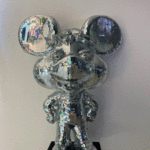PABLO MORGANTE was born in the city of La Plata on April 20, 1979.
He graduated in Visual Arts from the Faculty of Arts of the U.N.L.P.
He studied Architecture and Urban Planning at the U.N.L.P.
In 2015 he was awarded the “Clinical Workshop Scholarship for Visual Artists” from the Fund.
National Arts and Cultural Center H. Conti.
In 2006 he attended the residency scholarship at the Hoz del Júcar Art Institute, Spain;
awarded by the Karrvaz Foundation.
He held an art and work clinic with Diana Aisemberg, Daniel García, Ernesto Ballesteros, Silvia
Gurfein, Andrés Labaké, Tulio Desagastizabal, Verónica Gómez, Eduardo Basualdo.
He completed the Postgraduate Degree in Cultural Policies and Management, Faculty of Economic Sciences of the U.N.L.P.
He currently works as Head of the Chair of Painting III and Production Workshop
Plastic Arts from the Faculty of Arts, U.N.L.P. and as Head of Practical Work of the Chair of
Complementary Painting, Faculty of Arts, U.N.L.P.
His work is part of the collections of the Petorutti Museum, MACBA, MUMART and MACLA.










